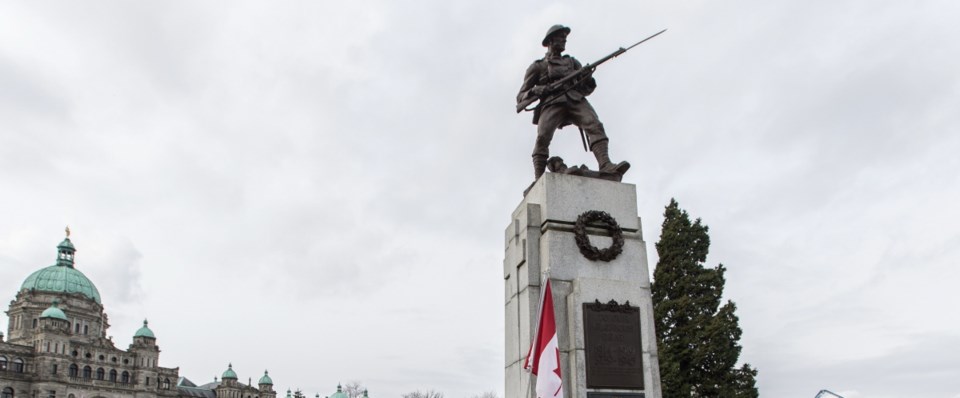Citizens, Armed Forces members and veterans will gather at the cenotaph at the B.C. legislature Friday to commemorate peacekeeping.
“There have been small missions and there have been big missions,” said Jim MacMillan-Murphy, president of the B.C. Chapter of the Canadian Peacekeeping Veterans Association and event co-ordinator.
“Nevertheless, we have remained soldiers of peace,” said MacMillan-Murphy. “As a nation we have left a real thumbprint on the world stage.”
Friday’s date, Aug. 9, was selected as National Peacekeepers’ Day to honour an incident on that day in 1974. Nine Canadian peacekeepers died when Syrian forces shot down their Buffalo transport aircraft on a supply mission in the Middle East.
It was the largest single loss of life of Canadian peacekeepers ever. Since 1949, the number of Canadians killed while serving on peacekeeping missions has reached 122, according to the Department of National Defence.
It was the province of B.C. that first declared Aug. 9 as the day to commemorate peacekeeping, beginning in 1993. The federal government didn’t follow suit until 2008 when it declared the date a national day of honour and recognition for peacekeepers.
Friday’s ceremony commences at 7 p.m. at the cenotaph, the soldiers’ war memorial statue at the corner of Belleville and Government Streets. CFB Esquimalt commander Capt. (N) Sam Sader and Randall Garrison, Esquimalt-Saanich-Sooke member of Parliament, will be guests of honour.
They will lay a poppy, symbol of peace and remembrance established during the First World War in the poem In Flanders Fields, written by Canadian soldier and physician Lt. Col. John McCrae (1872-1918).
It was after the Second World War and into the 1950s that the Canadian military first undertook duties as members of peacekeeping and observer units.
The signature moment for Canadian peacekeeping was in 1956 during the Suez Crisis. Lester B .Pearson, later became prime minister, but was then external affairs secretary of state, worked with the United Nations to defuse the situation.
The UN established a 6,000-strong emergency force to keep the peace. Canada contributed a battalion of the Queen’s Own Rifles and Canadian Gen. E.L.M. Burns took command.
Canadian legend says when Burns first arrived in Egypt he decided his uniform looked too British. To set a clear distinction he borrowed a blue field cap from an Italian admiral. Subsequently, UN peacekeepers would wear blue head gear, berets and helmets when on duty.
Pearson was awarded the Nobel Peace Prize for his Suez work. Canadian troops earned an international reputation as peacekeeping stalwarts.
Notable service has continued in places such as Cyprus in the 1970s, the Golan Heights between Syria and Israel in the1980s, and the former Yugoslavia and in the Rwanda civil war, both in the 1990s.
There have also been serious wrong steps, the most notorious being the 1993 beating and murder of a teenager in Somalia by members of the Canadian Airborne Regiment. Canada subsequently disbanded the regiment, conducted an inquiry and undertook reforms.
“Yes, there have been some challenges,” said MacMillan-Murphy. “But in all there have been far more successes.
Now 62, retired and living in Esquimalt he looks back with pride at his own peacekeeping deployments in Cyprus, between the Greeks and Turks, and in the Golan Heights, between Israelis and Syrians.
“When people think of the military they think of going in on the offensive,” said MacMillan-Murphy. “But when you do peacekeeping you go in and stand there to enforce the peace.”
“We would literally put our own bodies in front of armed combatants,” he said. “You won’t find too many other people willing to do that.”



